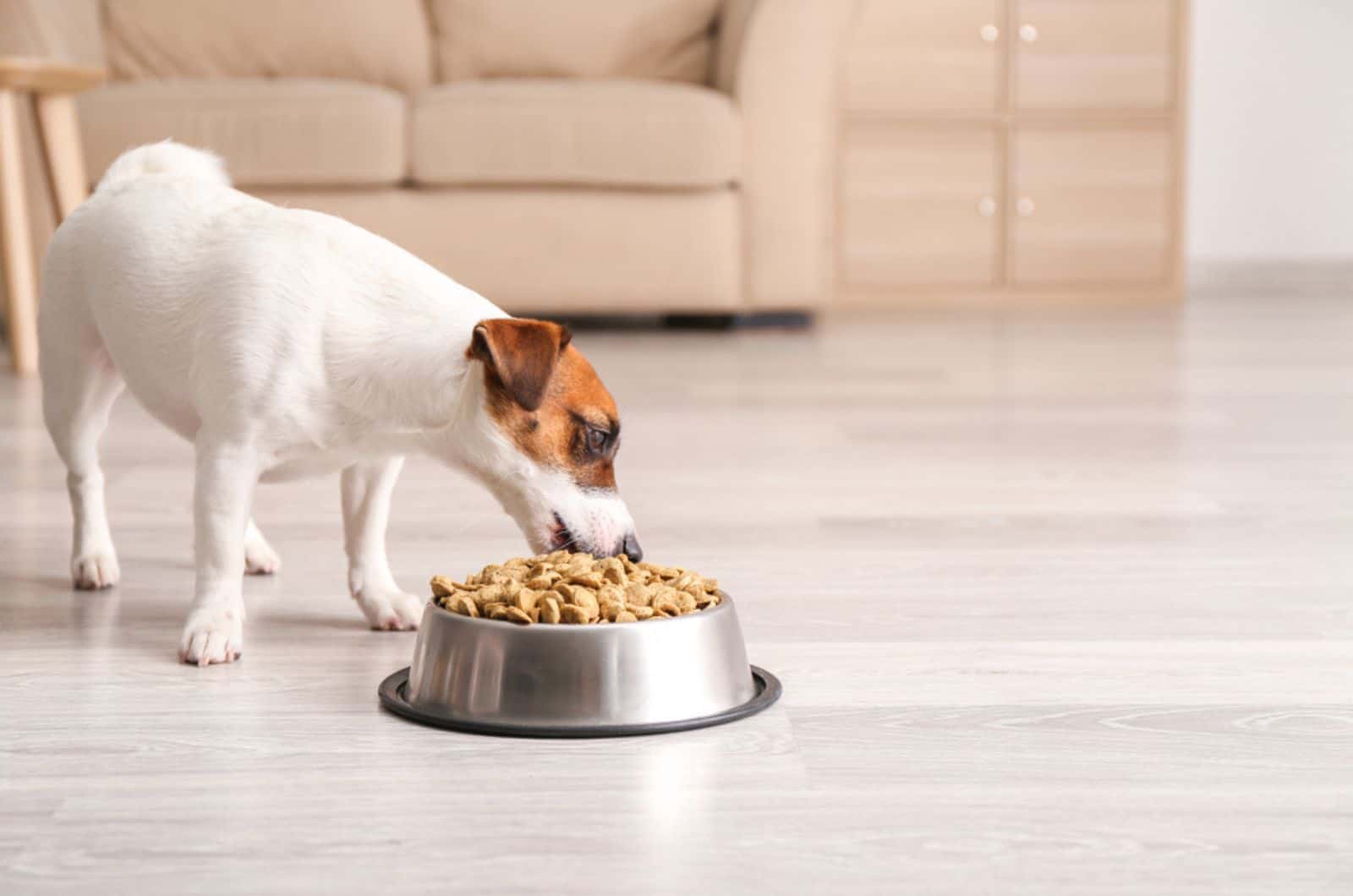Many dog owners fall victim to the woes of dog food diet planning. No one will tell you exactly how much, when and what type of food you should feed your dog. Most breeders skip this part as well.
If you are sick of getting answers that do not even scratch the surface, this article is for you. By the time you are done reading, you will feel more confident about what, when, and how much to feed your Jack Russel.
Yes. We will provide detailed information on puppy and adult feeding regimes and habits. This Jack Russell feeding chart will find its place among your bookmarks or favorite screenshots for sure.
Jack Russell Terrier Feeding Chart
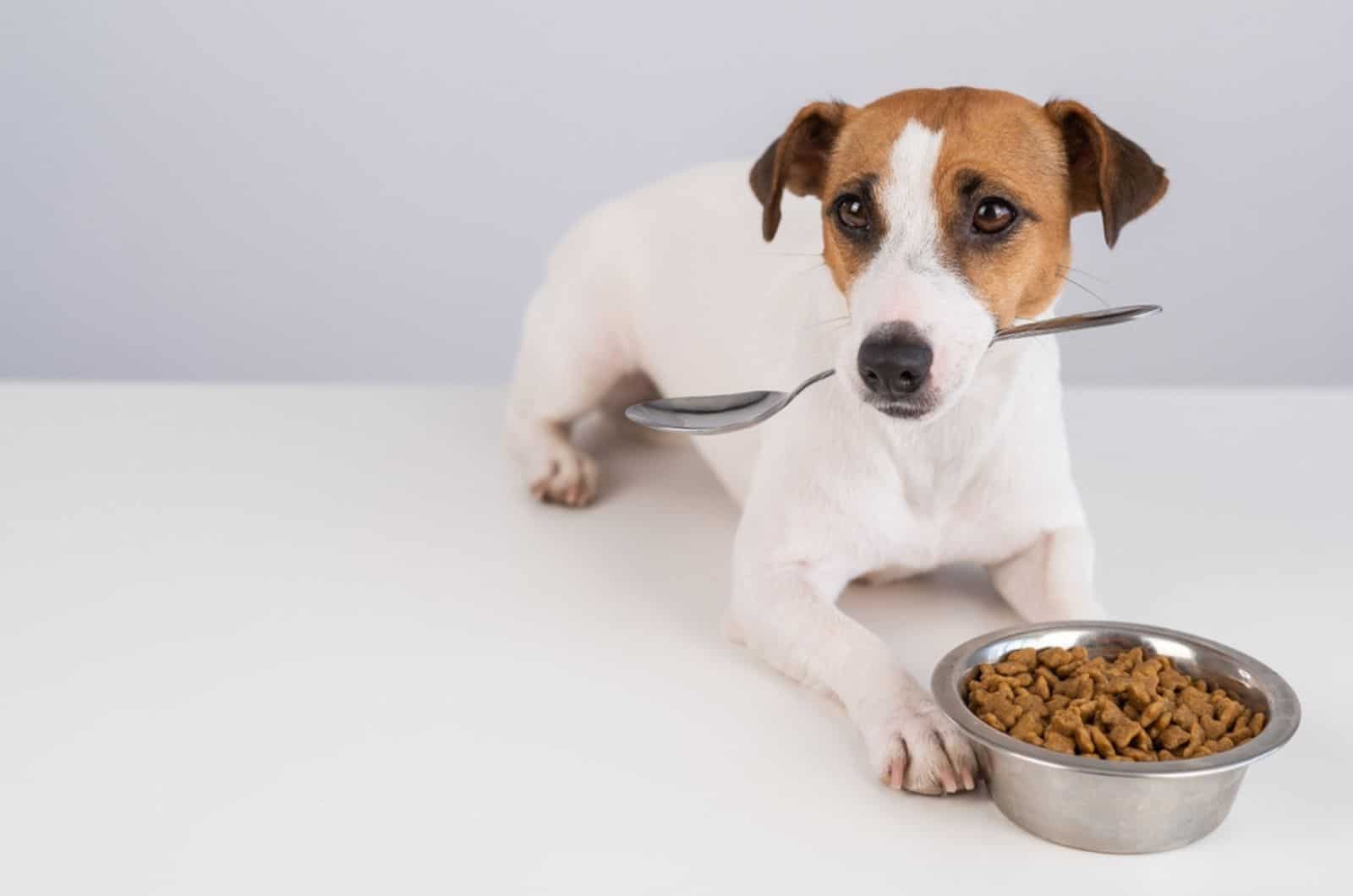
An eight-ounce cup will be your best friend for dosing the amount of food per meal. I decided to use a table with the dog’s age expressed in weeks because it will give you a more incremental way to adjust it to your dog’s needs.
The hero of the day will be kibble, dry dog food, and wet dog food. If you have the time and money and are willing to go for a raw or home-cooked diet, there is also a section dedicated to that part.
[table id=646 /]
Explaining The Chart
As you can see, there are crucial weeks when the daily amount of food increases and the number of meals decreases. Why is this? Well, your Jack Russell grows in “waves.”
The most significant weight gain occurs between the second and third month or the eighth and twelfth week of age. We have a detailed article on the Jack Russell’s growth with an accompanying growth chart. Check it out to monitor and adapt your dog’s diet appropriately.
For that reason, the number of meals goes from four to three, with an increase in daily amount. The ten to twelve ounces of daily sustenance will be enough for this small dog and should provide ample energy for a day full of activities.
Keep in mind that the amount of food shown in the chart assumes you are feeding the dog high-quality dog food. The nutritional value of cheap food is much lower than that of high-quality.
If your Jack Russell puppy’s diet consists of large amounts of fillers and carbohydrates, it can stunt its growth or create other health problems down the line. Puppy food should be rich in protein and fat for good development.
Vitamins and minerals are equally necessary, but high-quality foods usually have a good balance of all ingredients. Some charts on the internet will say that one meal is enough once the dog is fully grown, but I tend to disagree.
Puppy stomachs are more sensitive than adult dogs’ due to the continuous development of organic systems at an early age. Frequent smaller meals lower the chance of bloat, gastric dilatation, and volvulus (GDV).
Adult dogs are not immune to either of these conditions, and it is common with dogs who eat one large meal daily. It is better to spread the food into a morning and evening meal.
Jack Russell Terrier Puppy And Adult Feeding Guidelines
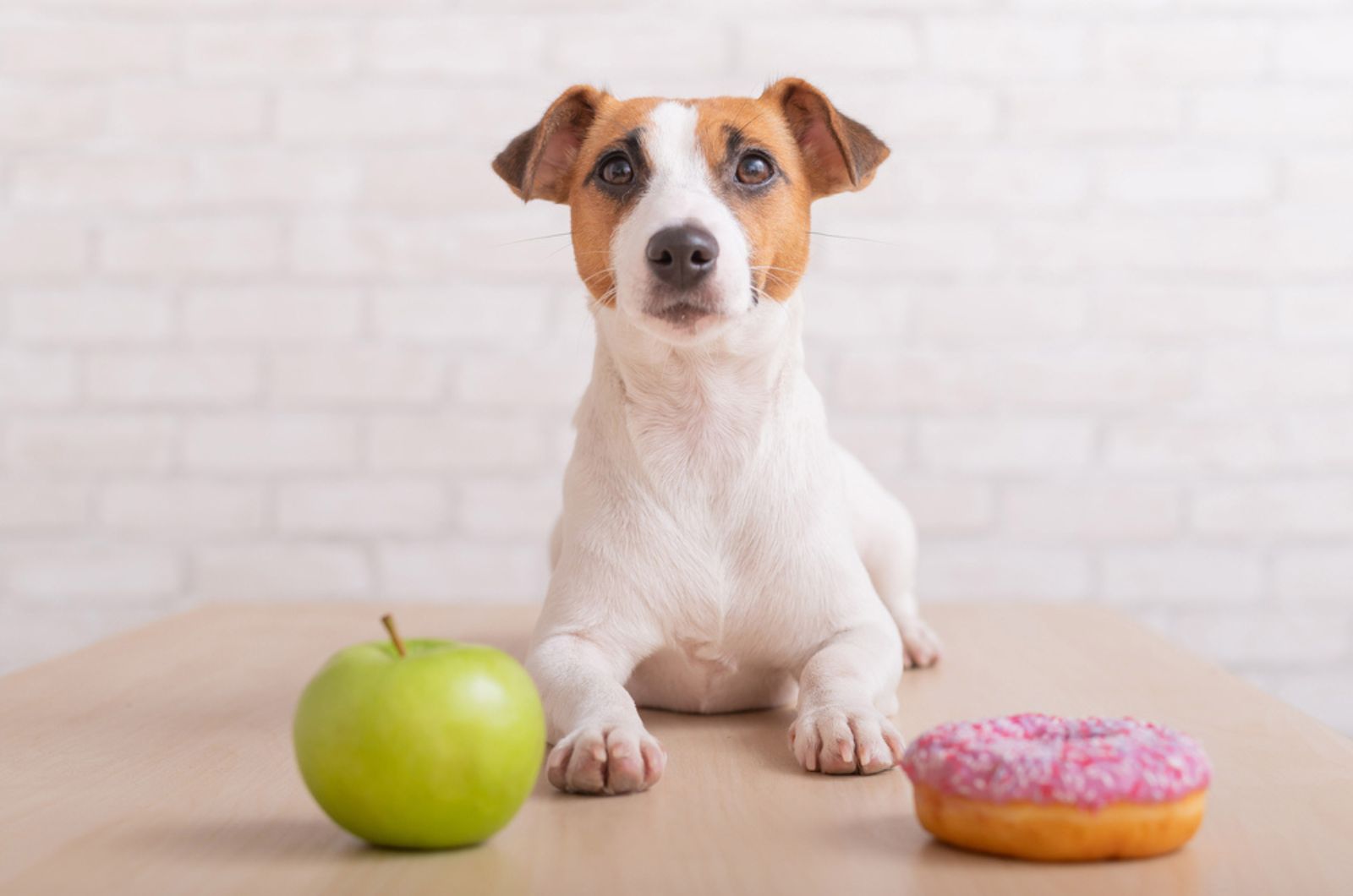
Adult dogs usually have a routine they adhere to. Puppies, however, tend to be a bit of a craving type of creature. They always want to eat, no matter how much food you feed them.
The provided chart is not set in stone. Your Jack Russell might be a bit bigger or smaller. It can be more energetic or lazy. Always take into consideration the character of the dog.
Puppies mostly eat when they are young. Running fast and zooming around the house is troublesome, with a rounded body and poor balance. Luckily, that problem solves itself — they grow fast and become more and more active throughout the day.
A small breed will obviously have smaller gains over time in terms of size and weight. This is why weighing them and measuring their height is of utmost importance. Obesity is a big problem in small breeds, particularly if the owners do not lead an active life or are often away from home.
The Balance Of Nutrients Is Key
Getting the right amount of food into your puppy’s belly is great. Having a balanced meal each time is perfect. I think we should talk about how a puppy’s diet differs from an adult dog’s.
There is a lot of talk about high-quality food, but you will rarely find an explanation of what it means. You can consider the dog food high-quality if it has been approved by the Association of American Feed Control Officials (AAFCO).
Protein, Fat, And Carbohydrates
When you choose kibble or wet food that has its certification, you can expect your dog to have an optimal nutritional balance. The main difference in puppy vs adult food is in the protein-to-fat ratio.
A puppy’s diet should consist of twenty-two percent protein and eight percent fat, while adult dogs’ dietary needs require eighteen percent protein and five percent fat.
Certain fatty acids, such as omega-3 and omega-6, make sure your puppy’s growing body develops strong bones, fast metabolism, an efficient digestive system, a resilient immune system, excellent eyesight, and normal brain function.
Feeding a Jack Russell means feeding a mean, lean machine. Despite their small size, they are dogs with high energy levels who have nutritional needs becoming of a terrier. For this reason, carbohydrates are an extremely important segment of a good diet.
While there are simple and complex carbohydrates, you should feed your dog only simple carbs. Complex carbs require a lot more energy and several processes in the intestine to be converted into energy, so simple is the way to go. These are usually vegetables such as yam, broccoli, etc.
Maintaining this ratio throughout your Russell’s growth period will allow you to switch to an adult feeding regime even before it is fully grown. For Jack Russels, the “puppy” can start an adult dog diet at twenty-six months of age.
Another consideration when choosing the food for your pup is caloric density. Puppy food has substantially more calories per serving than adult dog food. This is why an “early” switch to adult food can prevent obesity and weight gain in young adult dogs.
Do Not Forget The Vitamins And Minerals
The quality of food, more often than not, is determined by the supplemental nutrients that we often tend to forget in our own diets too. Vitamins and minerals play a major role in the formation of structural tissue in the body and hormone production.
At the top of the list are vitamins A, D, K, E, choline, and B-complex, while the minerals include calcium and phosphorus. These are the essential vitamins for proper development and healthy growth.
If you are wondering why vitamin C is not on the list, I can tell you that a dog’s body produces enough of it without needing its supplementation. It is important to note that most vitamins and minerals are already part of high-quality dog food.
Do not self-prescribe any dietary supplements unless your veterinarian suggests it is due to an underlying condition or vitamin/mineral deficiency.
Vitamin A has a role in good eyesight development and cell and immune system functionality. Vitamin D allows proper management of calcium and phosphorus in the body, allowing your dog’s bones and muscles to grow to their full potential.
Many conditions that affect dogs include problems with coagulation, and vitamin K makes sure that the platelets produced in the bone marrow perform their function of starting coagulation in a timely and efficient manner.
Blood oxidation is the main cause of getting old. Cells deteriorate as they lose regenerative function, thus weakening the entire body. This is where vitamin E comes into play. It is a crucial element in the defense against oxidative damage and a well-functioning immune system.
The B-Complex And Choline Deserve Their Own Headline
It is all about metabolism, neurological function, and synthesis with the B-complex. The word complex itself reveals that this is not just one vitamin, but a variety of them. For a high-energy breed, B-complex is a vital component of healthy living.
So, in a B-complex supplement, you will find thiamine (B1), riboflavin (B2), niacin (B3), pantothenic acid (B5), pyridoxine (B6), biotin, folic acid and cobalamins (B12).
Taking the title of “most important for a dog,” among all of them is pyridoxine. It helps the production of glucose in the liver, the normal functioning of the immune system and erythrocytes, hormone production, gene activation, and niacin synthesis.
Choline is to B-complex what Robin is to Batman — the inessentially crucial sidekick nobody talks about. Well, I am clearly talking about it, so that metaphor went out of the window.
High activity levels, especially in performance dog breeds such as Greyhounds, require incredibly fast metabolisms to quickly transform glucose into energy. However, terriers are incredibly athletic dogs that benefit from adequate choline levels.
It is the main player in the detoxification and nervous system maintenance game. Without choline, the liver would not be able to properly filter the blood, while nerve and motor function would be curbed with a choline deficiency.
Concentrated doses are used as a treatment for dogs that suffer from epilepsy and/or seizures. Paying attention to what nutrients the food contains can literally mean life or death in the long run.
What Is The Ideal Weight For My Dog?
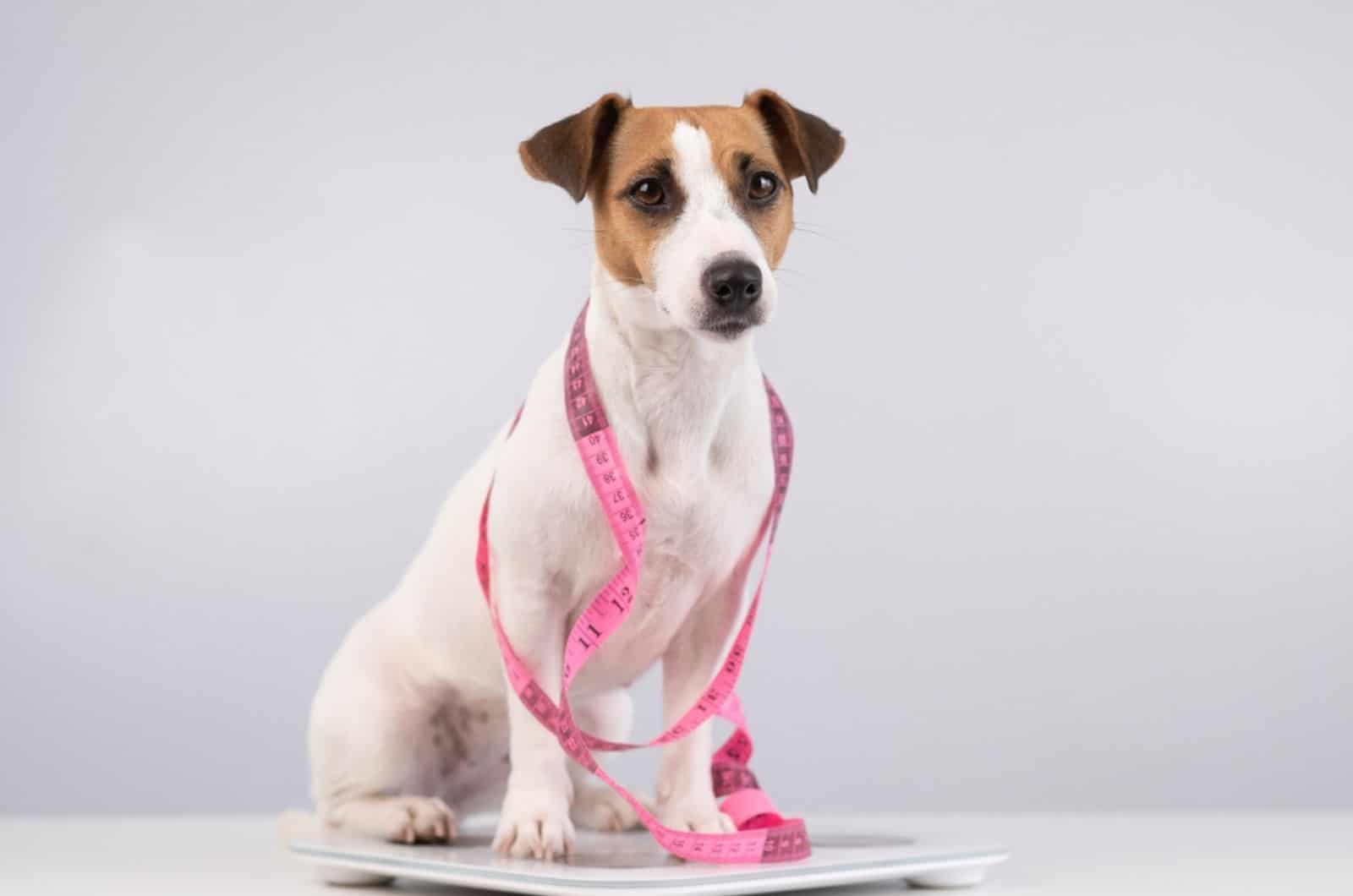
Small breeds show their excess weight much more easily. A big dog might look strong and powerful but be overweight. A short coat will show weight more easily too. How are you supposed to know your Russell’s perfect weight, then?
An eight-week-old Jack Russell should weigh anywhere between four and a half and five and a half pounds. Females should be slightly lighter than males, but the overall weight depends on the bloodline, activity levels, etc.
Should I Consider Raw And Home-Cooked Diets?
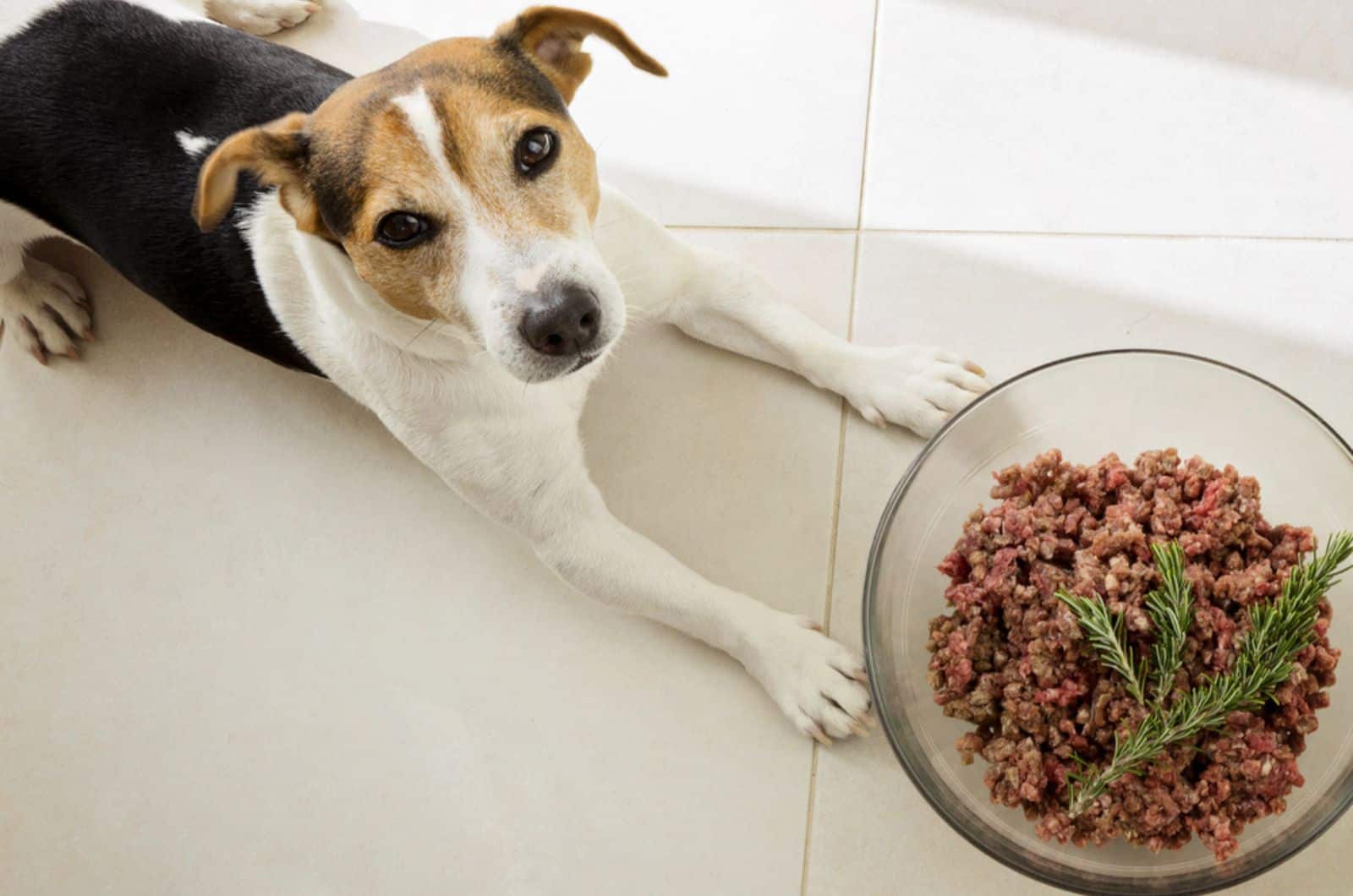
The best dog food will not always mean it comes as a commercially packed item. You can go all out and buy raw meat, veggies, oats, bone, organs, etc., or get prepackaged raw meals.
There is the option of home-cooked too — you get the ingredients and cook them just like you would for yourself. Well, not exactly like you would for yourself, just hold off the spice a bit.
The Good Side Of Raw And Home-Cooked
Whether prepackaged or bought individually, all the ingredients of a raw diet contain the right amount of nutrients a Jack Russell needs: protein, fat, carbs, vitamins, and minerals. If you opted for doing it yourself, you would have to check how much of each ingredient is enough for your dog.
Many owners claim that their dog is more energetic, has a better coat, and is overall in a better condition. However, there are no studies that prove this. Still, some things like an increase in energy levels and overall better condition are medically sound.
It is true that your dog might become more active with food that is absorbed faster. Equally, the efficient absorption of nutrients means a smaller stool, which will help both owners and dogs. A recipe such as boiled chicken is among the easiest home-cooked meals out there.
Remember to check what kinds of raw or cooked vegetables your dog can eat. Here is a list of articles to help you make the right decision for your dog’s veggie selection: Brussels sprouts, peppers, jicama, turnips, and artichokes.
The Bad Side Of Raw And Home-Cooked
While it all sounds delicious and nutritious, it is different in many aspects from kibble or canned wet food. For starters, you have to find good quality produce. If you consider muscle meat, organ meat, bones, vegetables, and potential supplements, a raw diet can become very expensive.
In addition, it takes time to prepare a balanced portion each time. If you do not have time to portion it all yourself, you can buy prepackaged raw meals. The only thing to pay attention to is the ingredient freshness and certification. More expensive meals do not guarantee higher quality.
Health risks such as bacterial, viral, or parasite infections are possible with raw food diets. No matter how fresh or well-assorted the meat, bacteria can find their way into anything. With raw diets, you are at risk too.
A very common bacteria that can be found in raw produce, such as meat, raw eggs, and dairy, is salmonella. If your dog gets infected, it might display symptoms such as diarrhea, vomiting, retching, or even more serious conditions like seizures.
The poop and vomit can spread the bacteria all around the house even after you have cleaned. This puts your family at risk too. Even before the food is eaten, you can easily spread germs just by touching the raw food.
Veterinary associations such as AVMA, the Center for Disease Control and Prevention, and many more health and medical organizations are strong opponents of feeding a raw diet to your dog.
Raw diets are a definitive no for puppies. Their immune and digestive system are too weak to handle infections, so that is a risk no dog owner should take with their dog.
Are Jack Russells Picky Eaters?
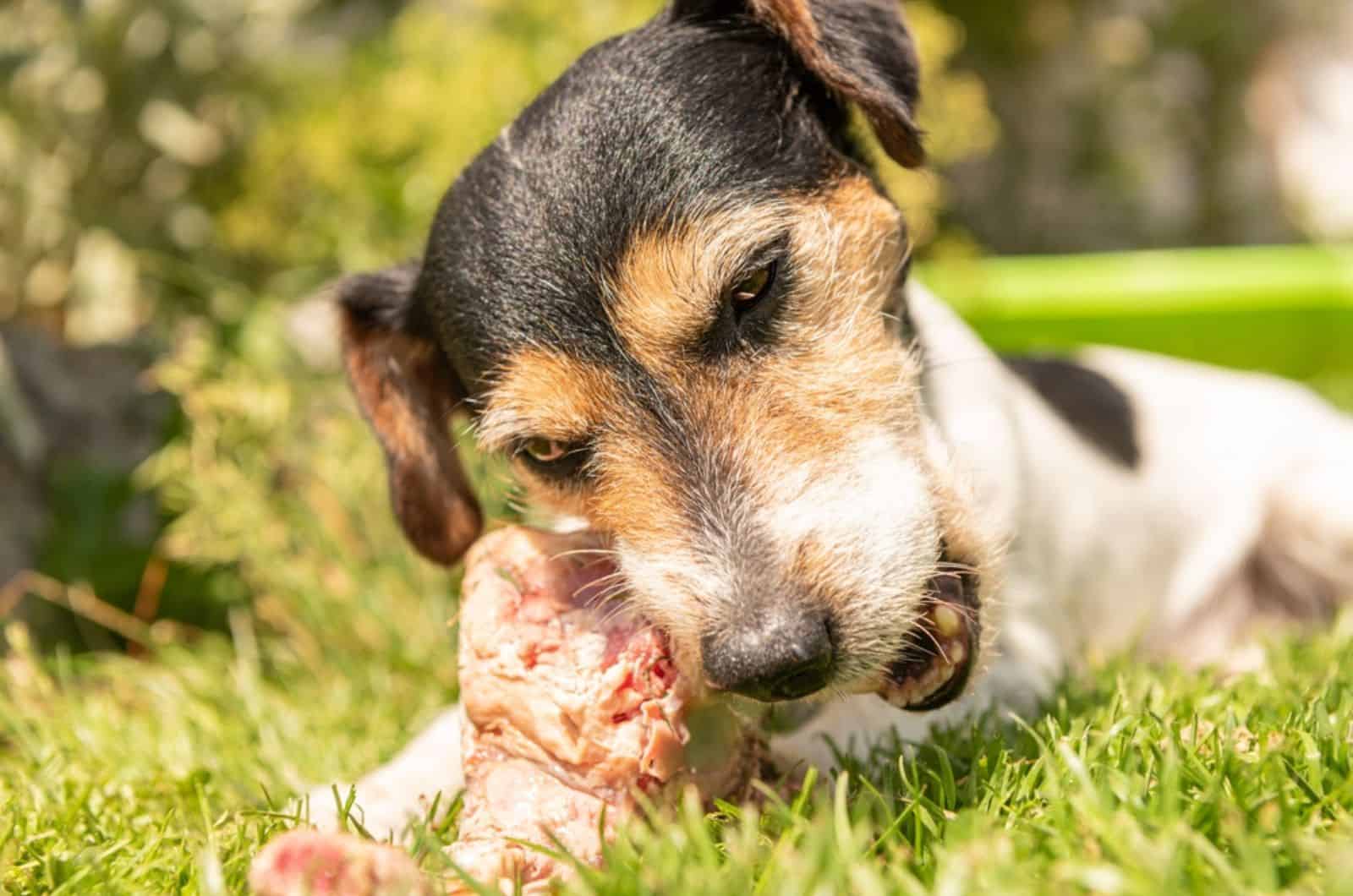
I would say they are not picky eaters. Most dogs, if fed a good diet, will not deny the opportunity of feasting. However, if your puppy loses appetite, it could be a health problem.
Since this is a small breed of dog, you must take into consideration that they might prefer smaller foods because they are easier to chew and bite. For a Jack Russell pup, you should always choose foods made for puppies.
Dogs can also be allergic to food. Before you make a switch to another diet or introduce something new into the mix, consult your veterinarian.
If you see a loss of appetite, sudden weight loss, excessive shedding, your dog scratching incessantly, etc., it is most likely food allergies. Luckily, they are easily treatable by simply removing the allergen from the diet.
Brachycephalic dog breeds are particularly susceptible to allergies, and sometimes their protein choices are very few due to being allergic to three or four different types of animal meat.
Your Dog’s Health Can Determine How Much Of What
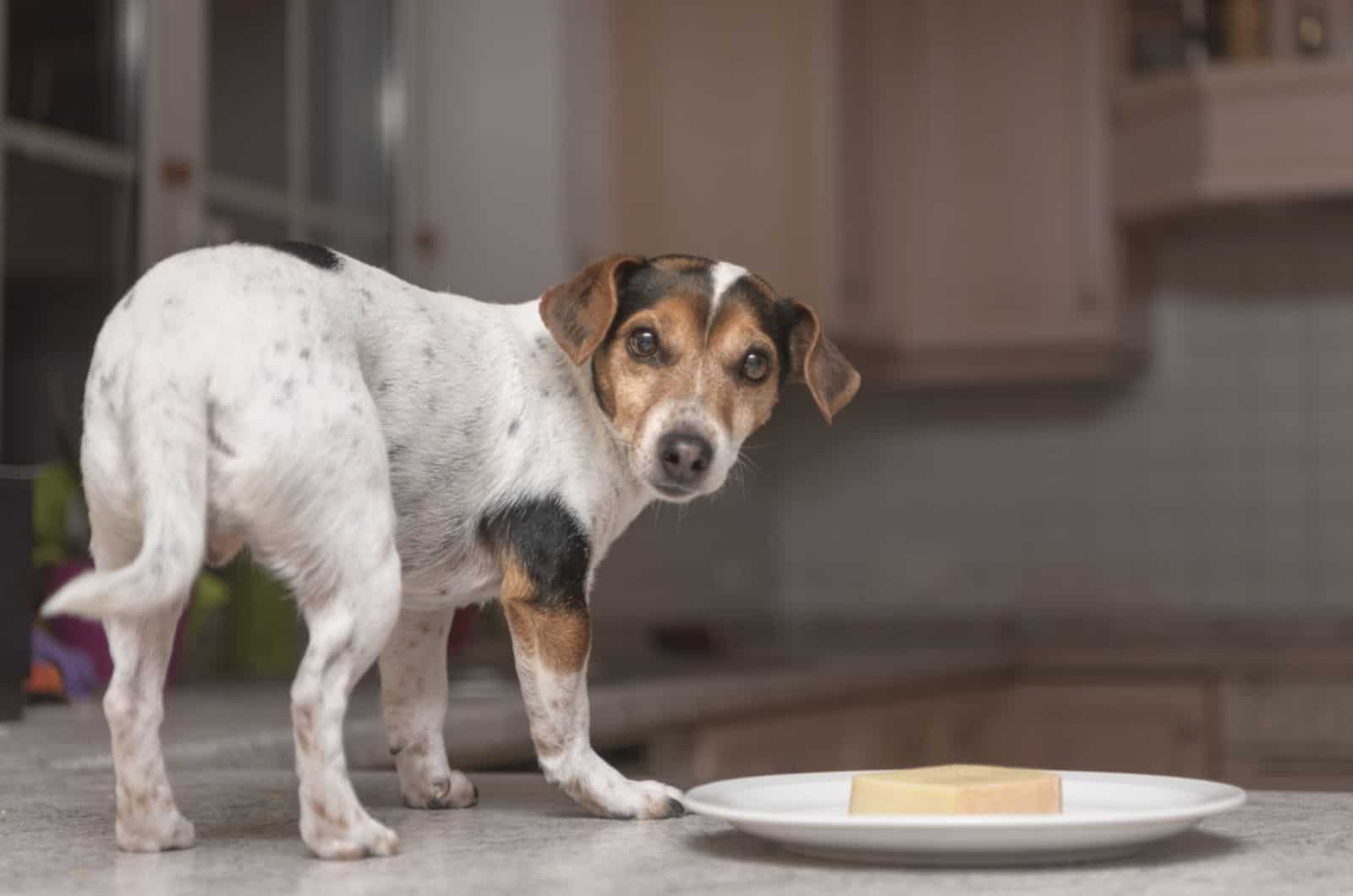
Food is the fuel that keeps your dog going. However, food can also be the cause of its misery. Overfeeding is one of the main problems with small-breed dog owners. A dog is always thinking about food, even while it is eating.
Giving treats too often can get your dog overweight in a blink of an eye. The calories from treats should always be counted toward the total amount of food eaten in a day. If you simply like giving your dog treats, then you need to intensify or prolong exercise time.
Since the right amount of every nutrient is necessary for a balanced diet, giving it too much of one can cause hypervitaminosis. Do not add any supplements to your Russell’s diet without the vet’s approval.
Obesity In Jack Russells
This is perhaps the most common owner-caused health condition in dogs. Feeding them scraps from the table, sharing snacks while watching a movie, or simply giving treats to please the dog is a dangerous habit.
Even if you feed your dog the most high-quality diet, too much will cause weight gain. With that, more health problems will follow.
The two most common possible health conditions caused by obesity are dysplasia and diabetes. High blood pressure or hypertension is also very common in dogs who have excess weight.
Hip Or Elbow Dysplasia
Most frequently, the excess weight causes hip or elbow dysplasia. Despite it being a congenital disease in most dogs, it can be caused by obesity. The ball and socket joint of the hip will start to falter under the excess weight, leading to tissue damage and eventually arthritis.
This can create a vicious circle of your dog being unable to exercise enough to burn the excess fat but also not getting the right nutrients to keep the body healthy. Once the joint is damaged, it cannot be reversed.
Cases that are diagnosed sooner rather than later require intensive physical therapy and NSAID use for the dog’s entire life. More severe cases require surgery that can have a long recovery period, in addition to being expensive.
Diabetes Mellitus
This health condition causes the dog’s body to produce insufficient insulin or not use the insulin in the way it was meant to. Insulin is crucial in the transfer of glucose into the blood cells, which creates energy.
Obese dogs have a higher chance of suffering from pancreatitis, and since the pancreas produces insulin, also diabetes mellitus. Insulin shots for the dog’s whole life and adequate dietary changes are the only treatment.
Conclusion
So, your Jack Russell puppy will eventually become an adult, and many of these concerns will perish from your mind. However, you will need to watch out for bad eating habits, such as treats and food outside of the scheduled eating plan.
I am sure that this Jack Russell feeding chart will help out if you are new to the dog feeding routine. Even if you are an experienced dog owner but not with this particular breed, it can come in handy.
The most important thing is a clear plan, high-quality food, and lots of exercise. It is always better to increase physical activity levels than to decrease food. Dogs burn calories much faster than we do.
Also, forget the couch potato business with your Russell — run, play, take trips to the beach or mountains and enjoy nature. Caring for your dog’s diet will undoubtedly make you better for it. Everybody stands to gain from it.
